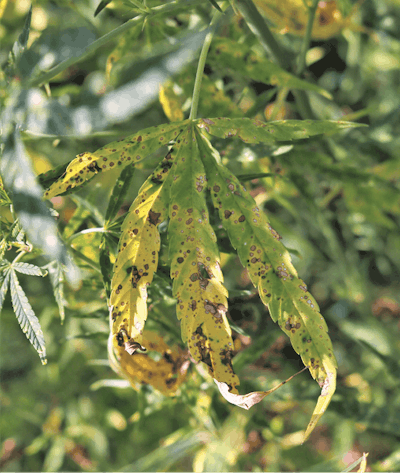

Hemp is susceptible to several diseases, some of which can be very damaging if left unmanaged. But hemp growers have tools available to minimize disease pressure. Here are five tips that will help reduce the severity of diseases in hemp crops.
1. Rotate crops.
Crop rotation is planting different crops in the same field in consecutive growing seasons. Hemp diseases such as southern blight, Fusarium wilt and certain foliar diseases can survive in the soil or on crop residue year after year. By following a hemp crop with an unrelated crop, growers can reduce the amount of overwintering pathogen inoculum and reduce disease pressure the next time they grow hemp in that field.
2. Select varieties that are disease-resistant.
Choosing disease-resistant varieties is the best way to manage plant diseases. Because hemp is still a relatively new crop in the U.S. following prohibition, information about disease susceptibility among hemp varieties is limited; however, more information is starting to become available. For example, in replicated field studies done by researchers at the University of Tennessee, the varieties Super CBD and Franklin were highly resistant to fungal leaf spots, whereas T1 and Cherry were much more susceptible. Knowing the most significant disease problems in a specific area and choosing disease-resistant varieties to combat those will reduce the need for chemical disease management and reduce economic losses to disease.
3. Sanitize the growing area and materials.
In greenhouse crops, sanitation is especially critical for reducing disease pressure, but sanitation principles can also apply to field crops. Sanitation involves regular scouting, removal of infested material and debris, and cleaning surfaces to reduce disease spread. Growers should sanitize year-round, from planting to harvest and post-harvest clean up. It’s best to start with clean, high-quality seed, seedlings or clones from a trusted source; make sure workers and visitors are clean before entering the greenhouse; and monitor insect pest populations, as several common insect pests can transmit hemp viruses.
4. Follow other good cultural practices.
Benjamin Franklin could have been talking about hemp production when he said “an ounce of prevention is worth a pound of cure.” All the tips discussed so far qualify as cultural practices to help with disease management, but growers have several more to consider. This is especially important for hemp because relatively few conventional pesticides are labeled for the crop, and certain consumer and retail markets may have very little tolerance for pesticide residue.
Growers should prioritize the following cultural practices:
- Avoid working with wet plants
- Manage weeds
- Disinfect surface irrigation water using physical or chemical water treatments approved for agricultural use
- Plant into well-drained soil
- Use drip irrigation instead of overhead irrigation
- Maximize air flow by planting on a slope when possible and spacing plants far enough apart to prevent overcrowding.
5. Properly diagnose issues.
If you do spot a symptom or sign of disease, the first step is to properly diagnose it. Nutritional disorders, herbicide injury and many other conditions are often confused with plant diseases. Without a proper diagnosis, problems may be left unresolved while time and resources are wasted trying to deal with the wrong issue. Growers should become familiar with their county or regional agricultural extension office, state extension specialists, and state diagnostic laboratory to assist with disease diagnostics.
















